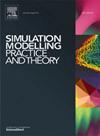B2RAM: Design and practical implementation of a secured information management framework for dynamic resource allocation using a novel 2-Tier blockchain model
IF 3.5
2区 计算机科学
Q2 COMPUTER SCIENCE, INTERDISCIPLINARY APPLICATIONS
引用次数: 0
Abstract
Resource allocation problems involve the intricate task of equitably and consistently distributing typically limited resources among competing clients, all while dealing with the issues of fairness, starvation, scalability and deadlock. The effectiveness of these solutions hinges on a secure and transparent underlying information flow model, ensuring timely and synchronized exchange of information about resource usage among the clients. Both centralized and distributed system architectures present their own challenges when devising such information flow strategies for optimal resource allocation. This paper efficiently addresses the constraints inherent in resource allocation and the associated information flows within a hybrid system-of-systems framework. It further integrates both distributed and centralized models while maintaining an optimal trade-off between the computational and communication costs. In this context, a secure and transparent information management framework is proposed, leveraging a novel 2-Tier blockchain model — B2RAM. The first Tier establishes a consortium blockchain within a distributed network, while the second Tier creates multiple private blockchain networks in centralized client–server models. Together, these two tiers establish a distinctive resource allocation policy that engages both cooperative and competitive users, further incorporating a novel dual-token model and resource ranking strategy. Extensive performance evaluation facilitates fine-tuning of B2RAM through parameter configurations and enhancement strategies. This not only refines its performance but also solidifies its superiority over existing models like greedy, Markov, prediction, random, and rank-based approaches. Finally, practical applicability of B2RAM is established through its implementation in Cognitive Radio Networks, where the operational feasibility is ensured through successful test-bed design and execution using a modular system framework.
B2RAM:使用新颖的2层区块链模型设计和实际实现用于动态资源分配的安全信息管理框架
资源分配问题涉及在竞争客户端之间公平和一致地分配通常有限的资源的复杂任务,同时还要处理公平性、饥饿、可伸缩性和死锁等问题。这些解决方案的有效性取决于安全和透明的底层信息流模型,确保客户端之间及时和同步地交换有关资源使用的信息。集中式和分布式系统架构在设计此类信息流策略以实现最佳资源分配时,都提出了各自的挑战。本文有效地解决了混合系统框架中资源分配和相关信息流的固有约束。它进一步集成了分布式和集中式模型,同时保持了计算成本和通信成本之间的最佳权衡。在此背景下,提出了一个安全透明的信息管理框架,利用一种新的2层区块链模型- B2RAM。第一层在分布式网络中建立一个联盟区块链,而第二层在集中式客户端-服务器模型中创建多个私有区块链网络。这两层共同建立了一种独特的资源分配策略,吸引了合作和竞争用户,进一步结合了一种新的双令牌模型和资源排名策略。广泛的性能评估有助于通过参数配置和增强策略对B2RAM进行微调。这不仅改进了它的性能,而且巩固了它比现有模型(如贪婪、马尔可夫、预测、随机和基于排名的方法)的优势。最后,通过在认知无线网络中的实现,建立了B2RAM的实际适用性,通过成功的测试平台设计和使用模块化系统框架的执行,确保了操作的可行性。
本文章由计算机程序翻译,如有差异,请以英文原文为准。
求助全文
约1分钟内获得全文
求助全文
来源期刊

Simulation Modelling Practice and Theory
工程技术-计算机:跨学科应用
CiteScore
9.80
自引率
4.80%
发文量
142
审稿时长
21 days
期刊介绍:
The journal Simulation Modelling Practice and Theory provides a forum for original, high-quality papers dealing with any aspect of systems simulation and modelling.
The journal aims at being a reference and a powerful tool to all those professionally active and/or interested in the methods and applications of simulation. Submitted papers will be peer reviewed and must significantly contribute to modelling and simulation in general or use modelling and simulation in application areas.
Paper submission is solicited on:
• theoretical aspects of modelling and simulation including formal modelling, model-checking, random number generators, sensitivity analysis, variance reduction techniques, experimental design, meta-modelling, methods and algorithms for validation and verification, selection and comparison procedures etc.;
• methodology and application of modelling and simulation in any area, including computer systems, networks, real-time and embedded systems, mobile and intelligent agents, manufacturing and transportation systems, management, engineering, biomedical engineering, economics, ecology and environment, education, transaction handling, etc.;
• simulation languages and environments including those, specific to distributed computing, grid computing, high performance computers or computer networks, etc.;
• distributed and real-time simulation, simulation interoperability;
• tools for high performance computing simulation, including dedicated architectures and parallel computing.
 求助内容:
求助内容: 应助结果提醒方式:
应助结果提醒方式:


